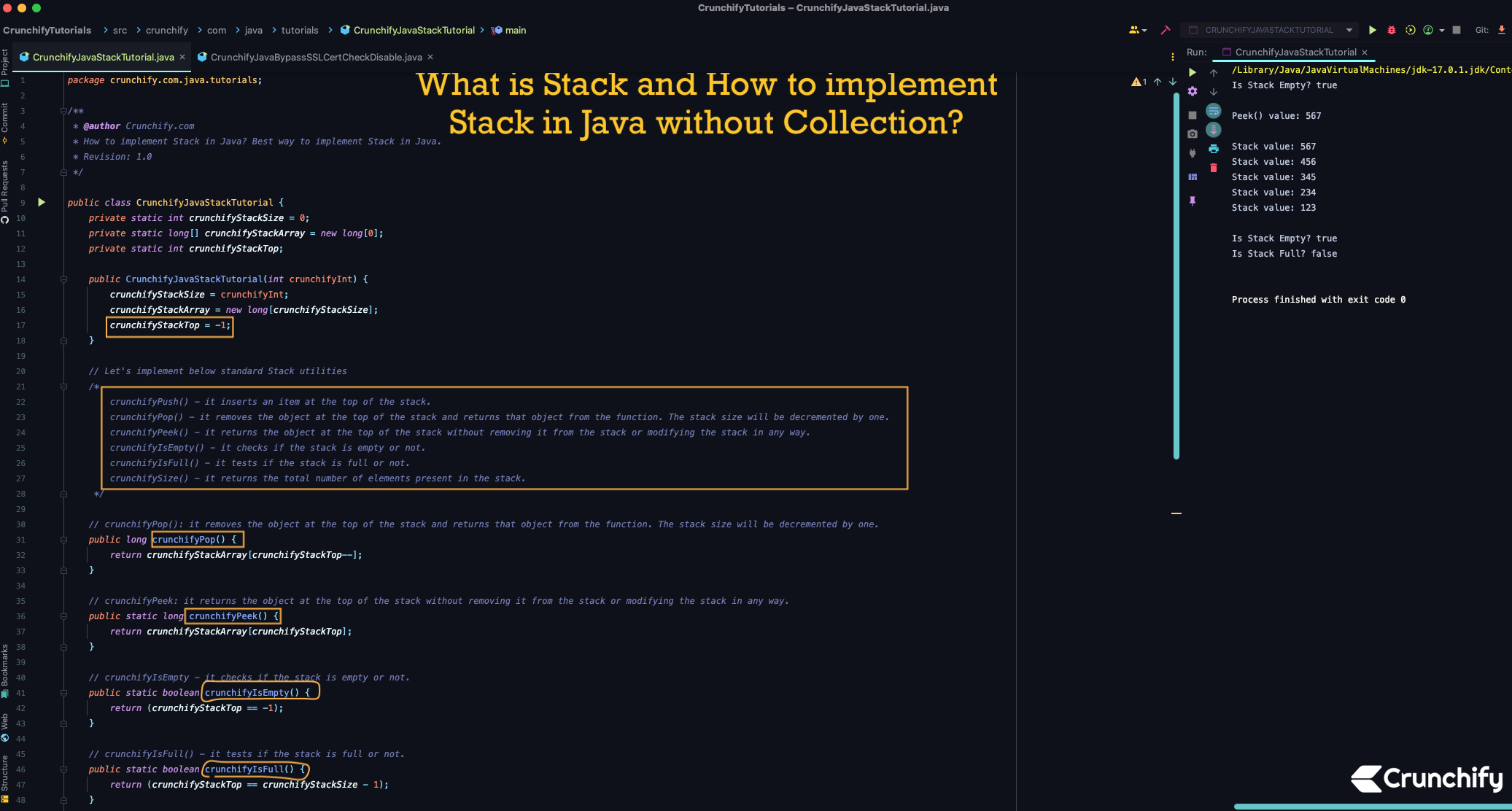¿Qué es Stack y cómo implementar Stack en Java sin colección?
Publicado: 2022-06-27
¿Qué es Stack en Java?
¿Has oído hablar de LIFO? ¿Concepto de último en entrar, primero en salir? Bueno, Stack es una implementación LIFO de estructura de datos lineal. Eso significa que los objetos se pueden insertar o eliminar solo desde un extremo O, en otras palabras, solo desde la parte superior.
Aquí está nuestra propia implementación de Stack en Java
Crearemos las siguientes funciones para Java Stack. Tenga en cuenta aquí: No estamos utilizando ninguna clase de colección de Java integrada para la implementación de Stack.
Usaremos Java Collection for Stack en el próximo tutorial. Ya está disponible Enlace del artículo.
- crunchifyPush(): inserta un elemento en la parte superior de la pila.
- crunchifyPop(): elimina el objeto en la parte superior de la pila y devuelve ese objeto de la función. El tamaño de la pila se reducirá en uno.
- crunchifyPeek(): devuelve el objeto en la parte superior de la pila sin eliminarlo de la pila ni modificar la pila de ninguna manera.
- crunchifyIsEmpty(): comprueba si la pila está vacía o no.
- crunchifyIsFull(): comprueba si la pila está llena o no.
- crunchifySize(): devuelve el número total de elementos presentes en la pila.
Empecemos:
- Crear clase CrunchifyJavaStackTutorial.java
- Copie el siguiente código en su Eclipse o IntelliJ IDEA.
|
1 2 3 4 5 6 7 8 9 10 11 12 13 14 15 16 17 18 19 20 21 22 23 24 25 26 27 28 29 30 31 32 33 34 35 36 37 38 39 40 41 42 43 44 45 46 47 48 49 50 51 52 53 54 55 56 57 58 59 60 61 62 63 64 65 66 67 68 69 70 71 72 73 74 75 76 77 78 79 80 81 82 83 84 85 86 87 88 |
package crunchify . com . java . tutorials ; /** * @author Crunchify.com * How to implement Stack in Java? Best way to implement Stack in Java. * Revision: 1.0 */ public class CrunchifyJavaStackTutorial { private static int crunchifyStackSize = 0 ; private static long [ ] crunchifyStackArray = new long [ 0 ] ; private static int crunchifyStackTop ; public CrunchifyJavaStackTutorial ( int crunchifyInt ) { crunchifyStackSize = crunchifyInt ; crunchifyStackArray = new long [ crunchifyStackSize ] ; crunchifyStackTop = - 1 ; } // Let's implement below standard Stack utilities /* crunchifyPush() - it inserts an item at the top of the stack. crunchifyPop() - it removes the object at the top of the stack and returns that object from the function. The stack size will be decremented by one. crunchifyPeek() - it returns the object at the top of the stack without removing it from the stack or modifying the stack in any way. crunchifyIsEmpty() - it checks if the stack is empty or not. crunchifyIsFull() - it tests if the stack is full or not. crunchifySize() - it returns the total number of elements present in the stack. */ // crunchifyPop(): it removes the object at the top of the stack and returns that object from the function. The stack size will be decremented by one. public long crunchifyPop ( ) { return crunchifyStackArray [ crunchifyStackTop -- ] ; } // crunchifyPeek: it returns the object at the top of the stack without removing it from the stack or modifying the stack in any way. public static long crunchifyPeek ( ) { return crunchifyStackArray [ crunchifyStackTop ] ; } // crunchifyIsEmpty - it checks if the stack is empty or not. public static boolean crunchifyIsEmpty ( ) { return ( crunchifyStackTop == - 1 ) ; } // crunchifyIsFull() - it tests if the stack is full or not. public static boolean crunchifyIsFull ( ) { return ( crunchifyStackTop == crunchifyStackSize - 1 ) ; } // crunchifyPush() - it inserts an item at the top of the stack. public void crunchifyPush ( long j ) { crunchifyStackArray [ ++ crunchifyStackTop ] = j ; } // crunchifySize() - it returns the total number of elements present in the stack. public static int crunchifySize ( ) { return crunchifyStackTop + 1 ; } public static void main ( String [ ] crunchifyArgs ) { CrunchifyJavaStackTutorial crunchifyStack = new CrunchifyJavaStackTutorial ( 5 ) ; crunchifyPrint ( "Is Stack Empty? " + crunchifyIsEmpty ( ) + "\n" ) ; crunchifyStack . crunchifyPush ( 123 ) ; crunchifyStack . crunchifyPush ( 234 ) ; crunchifyStack . crunchifyPush ( 345 ) ; crunchifyStack . crunchifyPush ( 456 ) ; crunchifyStack . crunchifyPush ( 567 ) ; crunchifyPrint ( "Peek() value: " + crunchifyPeek ( ) + "\n" ) ; while ( ! crunchifyIsEmpty ( ) ) { long crunchifyValue = crunchifyStack . crunchifyPop ( ) ; crunchifyPrint ( "Stack value: " + crunchifyValue ) ; } crunchifyPrint ( "" ) ; crunchifyPrint ( "Is Stack Empty? " + crunchifyIsEmpty ( ) ) ; crunchifyPrint ( "Is Stack Full? " + crunchifyIsFull ( ) + "\n" ) ; } // Simple Crunchify Print Utility private static void crunchifyPrint ( Object crunchifyValue ) { System . out . println ( crunchifyValue ) ; } } |
Ejecute el programa Java:
Simplemente ejecute el programa anterior como una aplicación Java y debería ver el resultado a continuación.

|
1 2 3 4 5 6 7 8 9 10 11 12 13 14 15 |
Is Stack Empty ? true Peek ( ) value : 567 Stack value : 567 Stack value : 456 Stack value : 345 Stack value : 234 Stack value : 123 Is Stack Empty ? true Is Stack Full ? false Process finished with exit code 0 |
Avíseme si tiene alguna pregunta o si obtiene alguna excepción que se ejecute por encima del programa Java y estaré más que feliz de depurar esto con usted.
